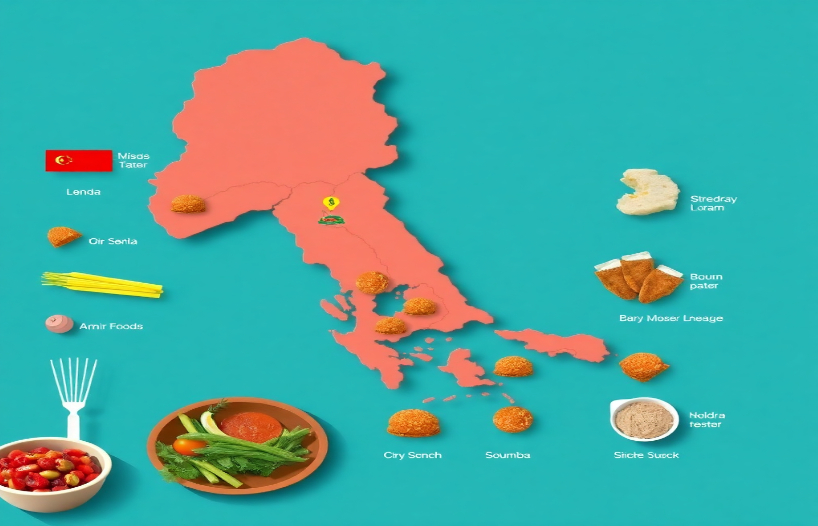Food is not just sustenance; it is a cultural symbol, a medium for storytelling, and a way to bring people together. Across the globe It is difficult to say which nation has the best food in the world because tastes in food are very individualized and influenced by regional specialties, cultural backgrounds, and personal preferences.
Countries take pride in their unique culinary traditions, and the debate over which nation has the best food is as timeless as it is subjective. In this article, we will delve into the culinary treasures of various nations, consider expert opinions, and examine key factors that make certain countries’ cuisines stand out.
7 Factors To Understand - What Defines “The Best” Cuisine?
Across the globe, each cuisine tells a unique story through its flavors, ingredients, and preparation methods. But what exactly makes a cuisine "the best"? While taste is inherently subjective, there are universal factors that contribute to elevating a culinary tradition to global acclaim.Let’s discuss these factors to better understand the criteria for defining “the best” cuisine.
1. Flavor and Balance
At the heart of any cuisine is its flavor profile. The best cuisines master the art of balancing tastes sweet, salty, sour, bitter, creating dishes that delight the palate. Some key considerations include:
- Complexity: Layers of flavors that reveal themselves with each bite.
- Harmony: Ingredients and spices complementing rather than overpowering one another.
- Authenticity: Staying true to traditional methods and recipes while adapting to modern palates.
For instance, Thai cuisine’s famous balance of sweet, sour, salty, and spicy flavors is a testament to its mastery of this principle.
2. Diversity and Creativity
The best cuisines offer a wide array of dishes and preparation methods. Diversity can come from regional variations, seasonal ingredients, or cultural influences. Creativity also plays a role, as chefs and home cooks innovate within their culinary traditions.
Examples of Culinary Diversity:
- India: The cuisine ranges from the spicy curries of South India to the rich, creamy dishes of the North.
Innovation within tradition, such as Japan’s modern sushi interpretations, ensures that cuisines remain dynamic and relevant.
3. Cultural and Historical Significance
Food often serves as a bridge to a nation’s history and traditions. The best cuisines are deeply rooted in their culture, reflecting stories of migration, trade, and adaptation.
Importance of Culinary Heritage:
- France: French cuisine’s emphasis on technique and presentation is a product of centuries of refinement, influenced by royal courts and regional farming traditions.
- Mexico: Mexican food tells the story of ancient civilizations like the Aztecs and Mayans, combined with Spanish influences.
Cuisine with rich cultural narratives often carries emotional and nostalgic value, making it more impactful.
4. Global Influence and Popularity
A cuisine’s ability to transcend its borders and appeal to international audiences is a significant indicator of its excellence. This global appeal often stems from accessibility, adaptability, and widespread recognition.
Examples of Global Reach:
- Italian: Pizza and pasta are staples in households and restaurants worldwide.
- Japanese: Sushi has become a global phenomenon, with variations tailored to local tastes.
The global influence of a cuisine also highlights its versatility and adaptability, as seen in fusion dishes that blend elements from different food traditions.
5. Health and Nutrition
The best cuisines not only taste good but also contribute to a balanced and healthy lifestyle. Traditional diets often incorporate a variety of fresh ingredients, whole grains, and lean proteins while minimizing processed foods.
Examples of Healthy Culinary Traditions:
- Mediterranean: Known for olive oil, fresh vegetables, and lean proteins, this diet is often associated with longevity and heart health.
- Japanese: Emphasizing portion control, fresh seafood, and fermented foods, Japanese cuisine supports overall wellness.
Cuisines that promote health without sacrificing flavor stand out as exemplary.
6. Presentation and Aesthetic Appeal
A dish's aesthetic appeal can improve the dining experience. The best cuisines often prioritize presentation, turning food into an art form. This includes the use of vibrant colors, thoughtful plating, and attention to detail.
Examples of Visual Elegance:
- France: Haute cuisine emphasizes intricate plating and beautiful arrangements.
- Japan: The art of kaiseki dining showcases seasonal ingredients with meticulous presentation.
Aesthetic appeal not only elevates the dining experience but also reflects the care and pride invested in the cuisine.
7. Community and Hospitality
Food is often a communal experience, bringing people together. The best cuisines foster a sense of connection and hospitality, whether it’s through shared dishes or welcoming dining traditions.
Examples of Community-Focused Traditions:
- Middle Eastern: Mezze platters encourage sharing and social interaction.
- Korean: Barbecue and banchan (side dishes) are meant to be enjoyed as a group.
Cuisines that emphasize sharing and community often leave a lasting impression.
6 Key Factors Related To The Subjective Nature of Food Preferences:
The subjective nature of food preferences highlights the complexity of our relationship with what we eat. Understanding why we gravitate toward certain foods and avoid others provides insights into human behavior, cultural diversity, and even societal trends.
1. Cultural Influences
One of the most significant factors shaping food preferences is culture. Culinary traditions passed down through generations dictate the flavors, ingredients, and preparation methods that define a person's palate.
Examples of Cultural Impact:
- Spice Levels: In countries like India and Thailand, spicy food is a norm, while many Western cultures prefer milder flavors.
2. Biological Factors
Biology plays a pivotal role in determining food preferences. Genetic differences influence how individuals perceive taste, smell, and texture.
Key Biological Factors:
- Taste Sensitivity: Some people are "supertasters" who find certain flavors, like bitterness, overwhelming.
3. Emotional Connections
Food is often tied to emotions and memories. A particular dish may evoke nostalgia, comfort, or even a sense of adventure, influencing preferences.
Emotional Triggers:
- Comfort Foods: Many people associate certain foods, like mac and cheese or chicken soup, with feelings of safety and warmth.
- Celebratory Dishes: Foods tied to celebrations, such as birthday cake or holiday feasts, carry positive emotional weight.
- Negative Associations: A bad experience, such as food poisoning, can lead to lifelong aversions.
4. Cultural and Generational Trends
Food preferences are also influenced by societal trends and generational shifts. What is considered "desirable" in one era may lose its appeal in another.
Examples of Trends:
- Health Consciousness: Modern preferences often lean toward organic, plant-based, or low-calorie options.
- Fusion Foods: The blending of cuisines, such as Korean tacos, reflects changing tastes in a globalized world.
5. The Role of Exposure
The more exposure a person has to different foods, the broader their palate becomes. Willingness to try new foods often correlates with openness to new experiences.
Key Factors:
- Travel: Experiencing local cuisines firsthand broadens one’s appreciation for diverse flavors.
- Media Influence: Cooking shows, food blogs, and social media introduce people to dishes they might not encounter otherwise.
- Peer Influence: Social settings can encourage individuals to try foods they might otherwise avoid.
6. The Subjectivity of Taste
At its core, taste is a subjective experience. What one person finds delicious, another might find unpalatable. Factors such as genetics, cultural background, and emotional connections create a unique "taste profile" for every individual.
The Complexity of Taste:
- Bitterness in Coffee: Some people enjoy the bitterness of black coffee, while others need it sweetened to be palatable.
- Seafood Aversion: For some, the taste and smell of seafood are delightful; for others, they are overwhelming.
Expert Opinions on the Best Cuisine:
The question of which country boasts the best cuisine is as subjective as it is perennial. While personal preferences play a significant role, the opinions of culinary experts, chefs, and food critics offer valuable insights into the world’s most celebrated cuisines. These experts, through their experiences and observations, help shape our understanding of what makes certain culinary traditions stand out. Let’s explore some expert opinions on the best cuisine
7 Top Countries for Culinary Excellence:
1. France: The Epitome of Culinary Sophistication:
France is often regarded as the birthplace of haute cuisine, with its focus on technique, presentation, and flavor refinement.
What the Experts Say:
- Renowned chef Julia Child famously said, "In France, cooking is a serious art form and a national sport."
- Alain Ducasse, a celebrated French chef, highlights the importance of technique in French cooking, describing it as "a discipline that transforms ingredients into magic."
Influence and Prestige:
French culinary schools, such as Le Cordon Bleu, have shaped the training of chefs worldwide. French techniques and dishes like coq au vin, soufflé, and crème brûlée set the gold standard in fine dining.
2. Japan: Precision and Harmony:
Japanese cuisine is renowned for its precision, balance, and focus on natural flavors. From sushi to ramen, it embodies artistry and mindfulness.
What the Experts Say:
- Chef Jiro Ono, celebrated in the documentary Jiro Dreams of Sushi, describes sushi-making as "a lifelong pursuit of perfection."
- Food critic Ruth Reichl praises Japanese cuisine for its attention to detail, stating, "Every meal feels like a carefully crafted experience."
Global Reach:
Japanese restaurants, from sushi bars to ramen shops, have become ubiquitous globally. The cuisine’s emphasis on fresh, seasonal ingredients has inspired food trends worldwide.
3. India: A Symphony of Spices:
Indian cuisine, with its rich tapestry of spices and flavors, is celebrated for its complexity and diversity.
What the Experts Say:
- Chef Madhur Jaffrey, a leading authority on Indian food, describes it as "an explosion of flavors that satisfies all the senses."
- Celebrity chef Gordon Ramsay has expressed admiration for the "depth and complexity" of Indian curries and biryanis.
Regional Diversity:
From the fiery curries of South India to the rich Mughlai dishes of the North, Indian cuisine showcases incredible regional variation. Its global popularity has surged, with dishes like butter chicken and masala dosa becoming household names.
4. Thailand: A Balance of Bold Flavors:
Thai cuisine is celebrated for its ability to balance sweet, sour, salty, and spicy flavors, creating dishes that are both vibrant and satisfying.
What the Experts Say:
- Chef David Thompson, known for his expertise in Thai food, describes it as "a cuisine of contrasts, where harmony is key."
- Food journalist Pim Techamuanvivit emphasizes the importance of freshness in Thai cooking, highlighting its reliance on herbs and spices.
Rising Popularity:
Thai dishes like Pad Thai, Tom Yum, and Green Curry have become global favorites, making Thai cuisine a contender for the best in the world.
5. Mexico: A Celebration of Heritage:
Mexican cuisine, recognized by UNESCO as an Intangible Cultural Heritage, is a vibrant blend of indigenous and Spanish influences.
What the Experts Say:
- Chef Enrique Olvera, of Pujol in Mexico City, highlights the deep connection between Mexican food and its cultural roots, stating, "It’s a cuisine that respects tradition while embracing innovation."
- Food writer Diana Kennedy has extensively documented Mexican cuisine, calling it "one of the most diverse and exciting in the world."
Signature Dishes:
Tacos, mole, and tamales are just a few examples of the rich variety found in Mexican cuisine. Its global influence continues to grow, particularly in North America and Europe.
6. China: Regional Diversity and Ancient Techniques:
Chinese cuisine is one of the most diverse in the world, with distinct regional styles such as Sichuan, Cantonese, and Hunan.
What the Experts Say:
- Chef Ken Hom, an authority on Chinese cooking, emphasizes the "incredible depth and history" of the cuisine.
- Food historian Fuchsia Dunlop describes Chinese food as "a sophisticated interplay of flavors and textures, honed over millennia."
Influence:
Chinese culinary techniques, such as stir-frying and steaming, have influenced other cuisines, and dishes like dumplings and Peking duck are beloved worldwide.
7. Italy: The Universally Loved Cuisine:
Italy often tops the list when experts are asked about the best cuisine. Known for its simplicity, quality ingredients, and robust flavors, Italian food has a universal appeal.
What the Experts Say:
- Massimo Bottura, chef of the three-Michelin-star restaurant Osteria Francescana, emphasizes the importance of tradition in Italian cuisine, describing it as "food that tells a story."
- Food critic Andrew Zimmern calls Italian cuisine "a celebration of fresh, seasonal ingredients," praising its ability to turn simple dishes like pasta and pizza into works of art.
Global Popularity:
Italian cuisine’s adaptability and comforting flavors make it a staple in households and restaurants worldwide. The Mediterranean diet, rooted in Italian culinary traditions, is also lauded for its health benefits.
Conclusion:
The question of which country has the best food in the world may never have a definitive answer, but that’s part of the beauty of global cuisine.Since everyone has different tastes in food, deciding which nation has the best cuisine in the world is inevitably subjective. However, because of its varied ingredients, great flavors, and cultural significance, many people view nations like Thailand, Japan, and Italy as leaders. Japan's focus on freshness and presentation, Thailand's harmony of sweet and spicy flavors, and Italy's pasta and pizza all highlight culinary expertise. The "best" meal is ultimately a subjective decision shaped by personal preferences, life events, and cultural upbringing. Accepting this diversity promotes appreciation for many culinary cultures and deepens our understanding of world food.








